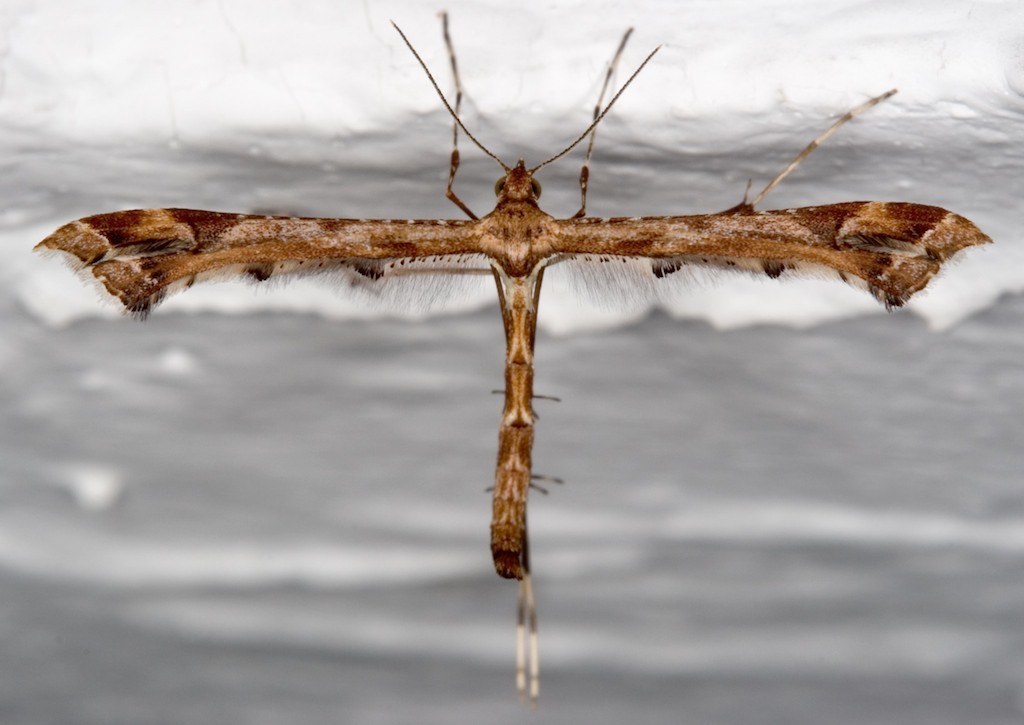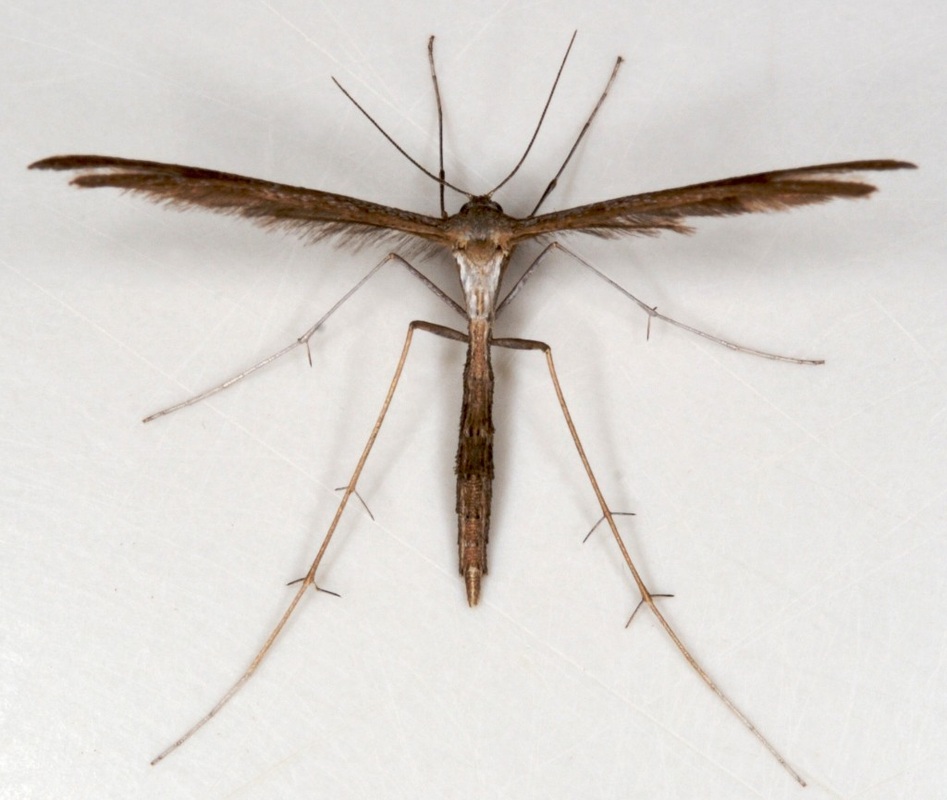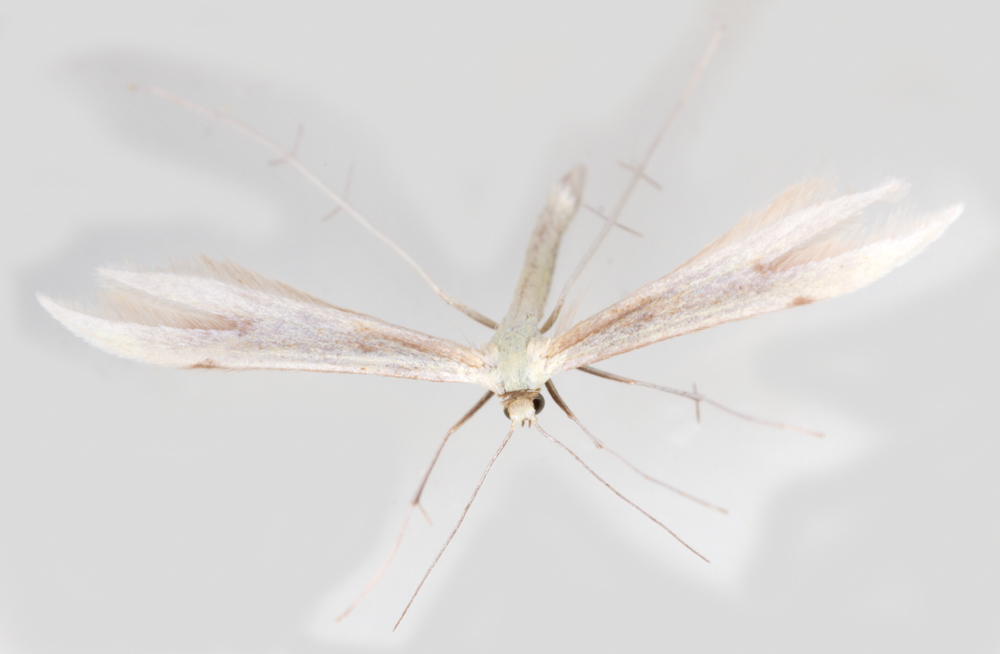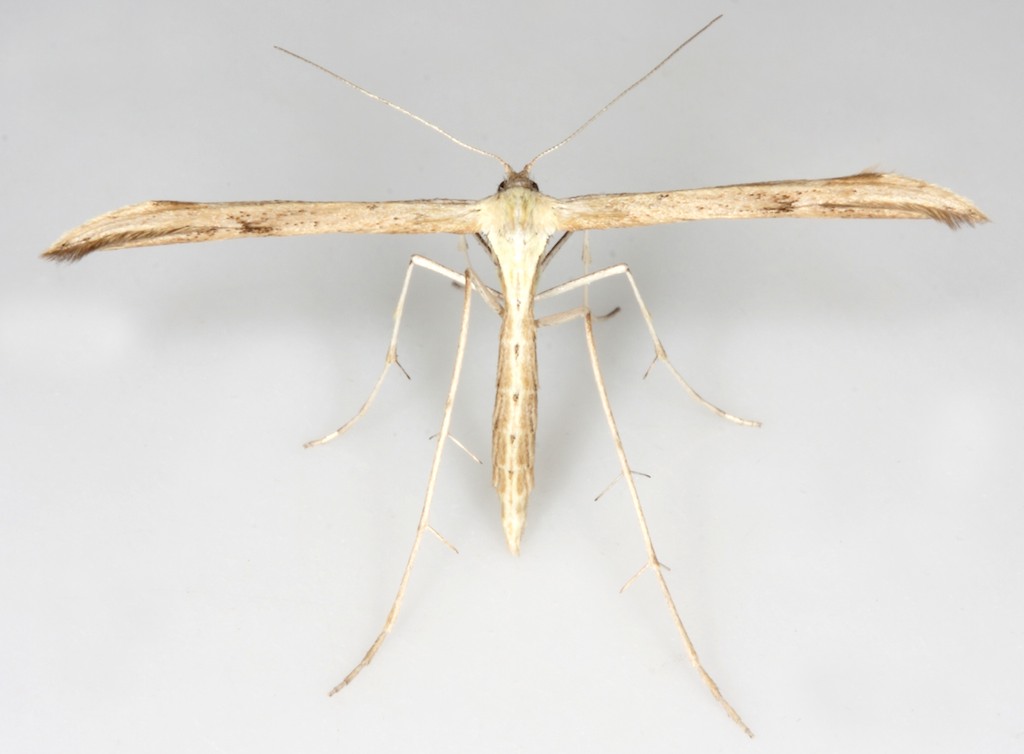Suborder:Glossata Infraorder:Heteroneura Superfamily:Pterophoroidea
Ref: Microlepidoptera of Europe Vol1 Pterophoridae, Gielis, 1996 used exclusively in initial publication of these pages
Additions and revisions from Nov 2012 onwards also refer to British Plume Moths, Hart, 2011
Order of genera and species now as in RES Checklist, Agassiz 2013
Ref: Microlepidoptera of Europe Vol1 Pterophoridae, Gielis, 1996 used exclusively in initial publication of these pages
Additions and revisions from Nov 2012 onwards also refer to British Plume Moths, Hart, 2011
Order of genera and species now as in RES Checklist, Agassiz 2013

These are the "plume moths'. Genus Agdistis, the sole member of subfamily: Agdistinae, has uncleft wings which are rolled and held forwards at rest, forming a 'Y' shape. The majority of genera are contained in subfamily: Pterophorinae and are readily recognised by their resting posture with the wings narrowly rolled up at held out laterally forming a 'T'-shape. The Pterophorinae have deeply cleft wings, the forewing with 2 lobes, the hindwing with 3 lobes. The cilia are moderately long, often longer than the width of the lobe they edge; they may show dark and light patterns and/or rows of scales forming one or more "scale-teeth". Wing venation is used as a distinguishing character in separating genera. Specialised scales distributed in rows on the underside of the hindwing are present in both males and females of all species. Ocelli absent. Maxillary palps absent. Labial palps 3-segmented, with appressed scales, porrect or ascending. Proboscis well-developed. Antennae range from 1/2 to equal forewing length. Long, slender abdomen and legs; forelegs shortest, hindlegs longest.
I had adopted the Gielis sequencing of genera (based on phylogenetic studies), and species (based on morphology).
The RES checklist, also based on phylogeny has reordered the genera to some extent.
I have grouped the genera of subfamily: Pterophorinae according to their defining features, following the key in Gielis.
However, the features separating the genera are largely based on venation (which I have not yet presented at all) and detail of the genital structure and so are not likely to help in identifying a live moth. The key in Hart is easier to use.
The RES checklist, also based on phylogeny has reordered the genera to some extent.
I have grouped the genera of subfamily: Pterophorinae according to their defining features, following the key in Gielis.
However, the features separating the genera are largely based on venation (which I have not yet presented at all) and detail of the genital structure and so are not likely to help in identifying a live moth. The key in Hart is easier to use.
Subfamily: Agdistinae
Wings not cleft; 'Y'-shaped at rest. Forewing with a wedge-shaped, sparsely scaled, "naked field", the base of the wedge being the central part of the termen.
Wings not cleft; 'Y'-shaped at rest. Forewing with a wedge-shaped, sparsely scaled, "naked field", the base of the wedge being the central part of the termen.
Agdistis (3S [1CI])
Subfamily: Pterophorinae
Wings cleft, forewing with 2 lobes, hindwing with 3 lobes; 'T'-shaped at rest.
Wings cleft, forewing with 2 lobes, hindwing with 3 lobes; 'T'-shaped at rest.
Group 1a: 3rd lobe of hindwing with 1 vein; 1st forewing lobe with a well-developed termen
Platyptilia (4S [1IR])
|
004 Platyptilia gonodactyla
(Triangle Plume) ws: 20-30mm; May-Oct; coltsfoot (Tussilago); common on grassland throughout GB 007 Platyptilia tesseradactyla
(Irish plume) Formerly on limestone downland in S.England. Extinct in GB. Now ireland only |
005 Platyptilia calodactyla
(Goldenrod Plume) ws: 18-25mm; Jun-Jul; goldenrod (Solidago virgaurea); NS-A - woodland in Norfolk, Kent, Sussex (?throughout England) |
006 Platyptilia isodactylus
(Hoary Plume) |
Gillmeria (2S)
Head with frontal scale brush. Palpi long, slender, porrect. Hindwing with weak scale-tooth on dorsum of 3rd lobe.
G.pallidactyla has plain hindlegs, G.ochrodactyla has brown rings on the hindlegs.
Head with frontal scale brush. Palpi long, slender, porrect. Hindwing with weak scale-tooth on dorsum of 3rd lobe.
G.pallidactyla has plain hindlegs, G.ochrodactyla has brown rings on the hindlegs.
Amblyptilia (2S)
Costal triangle well-developed. Forewing V11 present. Hindwing with strong central scale-tooth on dorsum of 3rd lobe (both British species have an addtional scale-tooth on the dorsal side of the apex of the 3rd lobe). A.acanthadactlya is red-brown, A.punctidactyla is brown-grey.
Costal triangle well-developed. Forewing V11 present. Hindwing with strong central scale-tooth on dorsum of 3rd lobe (both British species have an addtional scale-tooth on the dorsal side of the apex of the 3rd lobe). A.acanthadactlya is red-brown, A.punctidactyla is brown-grey.
|
010 Amblyptilia acanthadactyla
(Beautiful Plume) |
011 Amblyptilia punctidactyla
(Brindled Plume) |
|
Stenoptilia (10S[1EX,1DB])
Forewing V11 present. 3rd lobe of hindwing without a scale-tooth. Species very similar and probably require genital dissection to separate.
Forewing V11 present. 3rd lobe of hindwing without a scale-tooth. Species very similar and probably require genital dissection to separate.
|
015 Stenoptilia inopinata
(Scarce Plume) |
016 Stenoptilia gallobritannidactyla
(Snap-dragon Plume) Status uncertain but (inappropriately?) given a RES number in the main list |
017 Stenoptilia annadactyla
(Small Scabious Plume) ws: 17-24mm; Jun-Sep; small scabious (Scabiosa columbaria); first recorded 2005 Brecks, Norfolk and Settle, Yorkshire |
|
018 Stenoptilia islandicus
(Mountain Plume) ws: 17-19mm; Jun-Jul; tufted saxifrage (Saxifraga caespitosa); ?RDB very restricted distribution in Scottish Highlands |
019 Stenoptilia millieridactyla
(Saxifrage Plume) ws: 17-20mm; Jun-Jul; mossy saxifrage (Saxifraga hypnoides); NS-B in midlands and S.Scotland (UKMoths) |
020 Stenoptilia pneumonanthes
(Gentian Plume) Formerly on heaths in Dorset and Hampshire; last record 1969. Extinct in GB |
Group 1b: 3rd lobe of hindwing with 1 vein; 1st forewing lobe without a termen
Oxyptilus (2S)
Oxyptilus (2S)
|
024 Oxyptilus pilosellae
(Downland Plume) Chalk downland in SE.England. Was considered Extinct in GB - but rediscovered in Buckinghamshire Aug 2015 |
025 Oxyptilus parvidactyla
(Small Plume) ws: 13-18mm; Jun-Jul; mouse-ear hawkweed (Pilosella officinarum); local on heaths and chalk downland throughout GB |
Crombrugghia (2S)
Group 2a: 3rd lobe of hindwing with 2 veins; forewing V7,9&11 (R1,3&5) absent, V6 (M1) absent
Merrifieldia (3S)
Forewing with dark line along costa
Forewing with dark line along costa
|
032 Merrifieldia tridactyla
(Western Thyme Plume) ws: 18-23mm; Jun-Jul; wild thyme (Thymus); pRDB - chalk downland in SW.England |
033 Merrifieldia leucodactyla
(Thyme Plume) |
034 Merrifieldia baliodactylus
(Dingy White Plume) ws: 20-27mm; Jul-Aug; wild marjoram (Origanum vulgare); NS-B - chalk downland in S.England |
Wheeleria
|
035 Wheeleria spilodactylus
(Horehound Plume) ws: 20-25mm; Jul-Sep; white horehound (Marrubium vulgare); pRDB - few sites on chalk in S.England & S.Wales eg IOW |
Group 2b: 3rd lobe of hindwing with 2 veins; forewing V11 (R1) absent, V7-10 (R2-5) present; V6 (M1) present
Pselnophorus
Pselnophorus
|
036 Pselnophorus heterodactyla:
(Short-winged Plume) ws: 18-22mm; Jun-Jul; wall lettuce (Mycelis muralis), marsh hawk's-beard (Crepis paludosa); pRDB - woodland in Suffolk, Gloucester, Cumbria and Scotland |
Group 2c: 3rd lobe of hindwing with 2 veins; forewing V11 (R1) present, V7-10 (R2-5) present
|
Oidaematophorus
Scale brushes on midleg |
Hellinsia (5S)
Forewing cleft for 1/3 of its length |
|
040 Hellinsia lienigianus
(Mugwort plume) ws: 17-21mm; Jul; mugwort (Artemesia vulgaris); NS-B - grassland in England |
041 Helinsia osteodactylus
(Small Goldenrod Plume) ws: 16-23mm; Jul; goldenrod (Solidago virgaurea), ragwort (Senecio); local in oak wood in N.England and S.Scotland & N.Wales |
042 Helinsia chrysocomae
(Scarce Goldenrod Plume) ws: 18mm; Aug; goldenrod, common ragwort, goldilocks aster; RDB - woodland in SE England |
|
Adaina
Similar to Hellinsia and Emmelina but smaller and with hindleg proximal spurs of equal length and forewing cleft to 1/2 its length |
Emmelina (2S)
2nd and 3rd abdominal segments elongate: hindleg proximal spurs with medial spur 2x length of lateral spur |
Subfamily: Agdistinae (1G 2S +1CI)
Agdistis (2S +1CI)
Subfamily: Pterophorinae (19G 41S +2EX)
Platyptilia (3S +1IR), Gillmeria (2S), Amblyptilia (2S), Stenoptilia (9S +1EX), Cnaemidophorus, Marasmarcha, Oxyptilus (1S +1EX), Crombrugghia (2S), Capperia, Buckleria, Pterophorus, Porrittia, Merrifieldia (3S), Wheeleria, Pselnophorus, Oidaematophorus, Hellinsia (5S), Adaina, Emmelina (2S)
Agdistis (2S +1CI)
Subfamily: Pterophorinae (19G 41S +2EX)
Platyptilia (3S +1IR), Gillmeria (2S), Amblyptilia (2S), Stenoptilia (9S +1EX), Cnaemidophorus, Marasmarcha, Oxyptilus (1S +1EX), Crombrugghia (2S), Capperia, Buckleria, Pterophorus, Porrittia, Merrifieldia (3S), Wheeleria, Pselnophorus, Oidaematophorus, Hellinsia (5S), Adaina, Emmelina (2S)





















